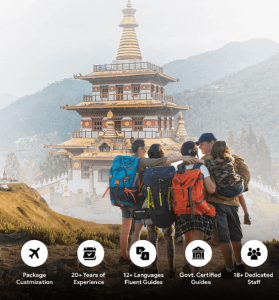Cultural excursions in Bhutan clearly demonstrate how deeply ingrained culture is in all facets of Bhutanese society. Vajrayana Buddhism serves as the main foundation for Bhutanese culture and traditions. Ancient Dzongs, temples, and chortens? all feature architectural representations of Bhutanese religious structures. These architectural marvels may be seen practically everywhere in Bhutan, perched on hilltops with views of expansive valleys. Booking Bhutan festival tours could be the greatest way for you to explore each and every aspect of Bhutanese cultural attractions which will remain in your memory forever.
Bhutanese cultural attractions you should not miss
Sacred Monasteries
Buddhism is a crucial component of Bhutanese culture because it is the country’s official religion and a significant component of the country’s customs. It should not come as a surprise that there are a lot of religious places all around the country, from large towns to rural areas, including monasteries, shrines, and chortens. Many of them are well-known national landmarks and popular tourist destinations, providing an exquisite grasp of Bhutanese culture.
Paro Taktsang (the Tiger’s Nest Monastery), a legendary monastery and the most recognizable symbol of Bhutan tourism in Paro, is a world-famous monastery that should be on every Bhutanese traveller’s must-see list.
Exquisite Chimi Lhakhang
Chimi Lhakhang is a Buddhist temple that is more frequently called “The Fertility Temple” and is situated in Sopsokha Village, Punakha District. The temple, which was constructed in 1499, is a well-known destination for Bhutanese pilgrims. Furthermore, Drukpa Kunley (the Divine Madman), an unconventional Buddhist monk, has a significant influence on the history of Chimi Lhakhang. Because of its unique beliefs that can’t be found anywhere else, the temple draws visitors from both within the country and beyond. Chimi Lhakhang, as its name in English suggests, represents the fertility belief, which is exemplified by the numerous phallus designs and paintings that can be seen around the town and the temple.
Visit eye-catching dzongs across the country
The dzong, which combines several duties including religious, military, administrative, and social functions, is not only a crucial component of Bhutanese cultural identity but also the country’s distinctively symbolic architecture. It is an enormous example of fortress architecture with high external walls enclosing a complex of courtyards, temples, offices, and quarters for the monks. Every dzong serves as the principal hub of its respective district, where the most significant occasions and customary celebrations also take place.
National Institute of Zorig Chusum
The National Institute of Zorig Chusum in Thimphu welcomes visitors to come and learn about the various delicate handmade goods of the country by providing a close look at Bhutanese traditional arts. The institute teaches thirteen traditional Bhutanese arts, such as drawing, carving, weaving, embroidery, and woodwork. The institute, which aims to introduce, preserve, and pass cultural heritages to future generations, is both an important monument to the people of Bhutan and a great eye-opener for foreign visitors concerning local artworks.
Ogyen Choling Palace Museum
Ogyen Choling Palace Museum, which once housed pieces of the ancestral home in the former residence of a ruling Bhutanese family descended from a 14th-century Buddhist teacher, is a welcoming cultural destination in the Bumthang District for those interested in the local way of life and housing conditions of a typical Bhutanese noble family in the past. Ogyen Choling Palace Museum, situated on a hilltop with stunning views of the valley, is roughly a couple of hours’ drive outside of the main town.








